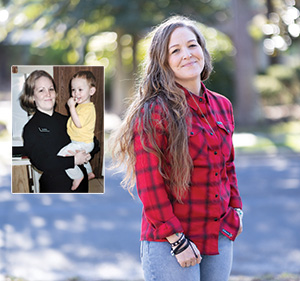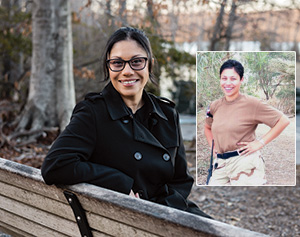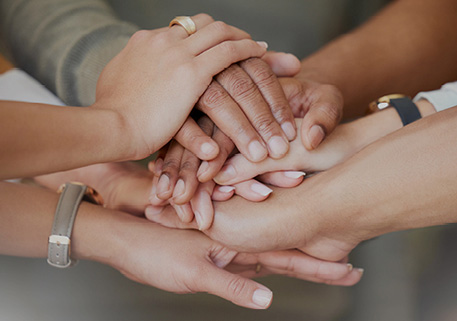

For 15 years, Jennifer Alvarado lived in survival mode. She struggled to hold a job, was at risk of homelessness and relied on food banks to feed her family. It was exactly the kind of life she hoped to avoid when she joined the Navy as a 19-year-old single mom.
But after years of intimate partner violence compounded by military sexual trauma, Alvarado felt lost. At times, she found solace in drinking, and during one phase in her life, she considered suicide.
“Once I got out [of the Navy], there was no transition from military to civilian,” Alvarado said. “They sent a woman with two children and a serious history of domestic violence out into the world, and I had no idea what to do with myself.”
When Alvarado sought help through the Department of Veterans Affairs, she was often left disappointed. She said she was sexually harassed at her local VA clinic and that her benefits claim for depression was denied, though doctors piled on prescriptions.
Stories similar to Alvarado’s are common among women veterans, as highlighted in a new report from DAV. Women Veterans: The Journey to Mental Wellness is a comprehensive assessment of the unique factors contributing to the staggering rates of suicide among women veterans. According to data released by the VA in November 2023, the suicide rate among women veterans jumped 24.1% between 2020 and 2021—nearly four times higher than the 6.3% increase among male veterans and vastly higher than the 2.6% increase among nonveteran women.
Women Veterans: The Journey to Mental Wellness shows that key factors, including high rates of military sexual trauma and intimate partner violence, substance use disorders and reproductive health challenges, put women veterans at higher risk for suicide. The report further reveals how the system charged with women veterans’ mental health care—the VA—can and must do better.
“We know that the VA is uniquely positioned to deliver the best and most comprehensive health care to our women veterans, especially those who have suffered injury or illness as a result of their military service,” said DAV National Legislative Director Joy Ilem. “We also recognize that the VA has made concerted and significant progress in engaging, serving and understanding this particular population.
“However, there is much work to be done to ensure equity in services and health outcomes for women, the fastest-growing demographic of veterans and one that historically has been underserved. With the research and recommendations in this report, we look forward to propelling that work forward alongside the VA and Congress.”
The report also includes personal stories of women veterans like Alvarado who are eager to be part of the conversation and the solution.
“The only way for change to happen is to talk about the ugly stuff,” Alvarado said.
‘TOTALLY BROKE MY SPIRIT’


Marine veteran and DAV benefits advocate Carmen McGinnis knows the ugly stuff well. She enlisted on Sept. 11, 2001, the day after she turned 17. She eventually deployed to Afghanistan doing long-range aircraft surveillance and ballistic missile defense.
Yet the most difficult part of McGinnis’ six years as a Marine wasn’t facing down the enemy. It was the torment of repeated sexual harassment and a violent sexual assault.
She’s not alone. Among women veterans who use VA care, around 1 in 3 report experiencing military sexual trauma (MST), which refers to a spectrum of sexual harassment, assault or both. Veterans with a history of MST experience a higher prevalence of substance abuse and are at increased risk for suicidal thoughts and behaviors, the DAV report shows.
Following the assault, McGinnis was offered little in the way of mental health care in the military. She threw herself into work; overexercised; experienced insomnia; and, she said, lost an unhealthy amount of weight. In 2008, she separated from the military.
“It was just really hard getting out,” McGinnis said. “I didn’t know the VA existed to help me.”
Meanwhile, she was dealing with undiagnosed post-traumatic stress disorder related to the assault. At one point, she didn’t care whether she lived. It wasn’t until after both of McGinnis’ parents died that she finally sought help, finding VA services through a Google search. She credits the VA therapist she found with saving her life.
But McGinnis has also seen the gaps firsthand. When she worried she was drinking too much, she told her VA primary care provider, hoping he would recognize her risk factors.
“He said, ‘Well, as long as you’re drinking red wine, that’s good for you, so there’s no problem,’” McGinnis recalled. “It just totally broke my spirit of asking for help or doing anything.”
McGinnis said she was able to curb her drinking with the help of her existing support system, but she knows not everyone is so lucky.
DAV’s report recommends that the Veterans Health Administration (VHA) improve screening for substance use disorder and asks Congress to require that the VA undertake a strategic refresh of its suicide prevention strategy to more explicitly include issues affecting women veterans. It also asks VHA to ensure every VA medical center has at least one full-time MST coordinator and that veterans are effectively screened and referred using trauma-informed care approaches.
‘IT NEVER GOES AWAY’


Like Alvarado, Naomi Mathis joined the Air Force as a young, single mom to give her children a better life—a goal she says came to fruition. And despite the turmoil she experienced during and after service, there’s little she would change.
“The only thing I would change would be that we didn’t lose Griff,” Mathis said, referring to Staff Sgt. Patrick L. Griffin Jr.
Griffin was killed in an accidental detonation of unexploded ordnance on May 13, 2003, while riding in a convoy into Iraq. Mathis was in the same convoy.
When she left Iraq, Mathis became an instructor and “slowed [her] life down.” That’s when she started experiencing what would later be diagnosed as severe PTSD. She also experienced suicidal thoughts.
The most sobering wakeup call came in 2006 after the birth of her son. She doesn’t know if it was hormones or the cocktail of medications she was on for PTSD, but Mathis started experiencing what seemed to be severe symptoms of post-partum depression.
“I immediately was terrified,” Mathis said.
She quickly saw her TRICARE doctor and demanded a change in treatment. She also started therapy.
“Thanks to therapy and medication, I can continue on and live a productive life,” she said. “But it never goes away. The homicidal, suicidal ideations, all of that … noise is gone. But when it comes to PTSD, that stays with you for life.”
Mathis’ story illustrates the unique risk factors women veterans can face during and after pregnancy. Research shows that veterans using VA maternity care are more likely than the general population to have one or more mental health diagnoses, including PTSD, which can put them at greater risk for issues including suicidal ideation.
Mathis noted that VA maternity care is outsourced to community providers in non-VA facilities, so having a VA maternity care coordinator to help women navigate their care during pregnancy is critical.
“It is extremely important that there is open communication between veterans and providers, and a warm handoff between the VA and community partners during this critical period is essential,” Ilem said. “We are particularly concerned about veterans falling through the cracks between maternity services and suicide prevention programming.”
The DAV report recommends that the VA’s Office of Women’s Health and Office of Mental Health and Suicide Prevention collaborate to define how local suicide prevention coordinators, maternity care coordinators and women’s health clinical leaders can better work together to support at-risk pregnant women veterans.
‘A PERFECT STORM’
An even more vulnerable time for women veterans is during menopause. According to the report, this period corresponds to the highest rates of suicide in U.S. women.
Usually beginning between ages 45 and 55, menopause comes with fluctuations in hormone production and is often accompanied by a variety of symptoms, including hot flashes, sleep disruption, body aches, weight gain, incontinence and memory problems. Menopause has also been shown to raise the risk for depression in U.S. women twofold, the report notes.


“Any woman at their healthiest, best mental state gets hit with menopause [and] can really be affected by it,” said Air Force veteran Maria Luque, an alumna of DAV Patriot Boot Camp for entrepreneurs and the founder of Fitness in Menopause. “Let’s layer on the combat part of maybe a woman veteran, and let’s layer on the possible sexual trauma that happened during military service as well.”
Luque called it a “perfect storm.” About three years ago, she found herself in the middle of that storm when she started experiencing crippling anxiety.
“It just stopped me,” Luque said. “I have a small child, so that’s kind of like the only thing that kept me going at that point, because I thought there’s someone that really relies on me.”
Despite holding a doctorate in health sciences and studying menopause for over a decade, the symptoms took Luque by surprise. She eventually broached the topic with her VA doctor (whom she called “fantastic”) and quickly got the care she needed.
However, Luque said a majority of the women she’s talked to about menopause—including civilians who receive health care through the private sector—say they have felt dismissed by doctors.
“And when you get dismissed like that … it’s very hard to kind of bounce back,” Luque said. “We need to do better.”
DAV recommends the VA convene a meeting of experts in menopausal women’s health to consider a research agenda, which could look at the impact of polypharmacy—taking five or more prescribed medications at once—and hormone replacement therapy among menopausal women veterans.
“A significant portion of women veterans using VA health care have comorbid conditions and fall into a high-risk category because of their PTSD, depression and/or substance use disorder, yet the impact of menopause on mental health among women veterans is poorly understood,” Ilem said. “It is critical that we invest in research and resources, particularly in the way of suicide prevention, treatment options and peer support, to better serve these veterans.”
‘NOT THE END’
DAV has long been at the forefront of advocating for policy and legislative changes to better serve women veterans, who now represent more than 10% of all veterans. Most recently, DAV helped pass the Protecting Moms Who Served Act to improve maternity care, the Making Advances in Mammography and Medical Options (or MAMMO) for Veterans Act to improve access to mammograms, and the historic provisions from the Deborah Sampson Act aimed at enhancing health care programs and services for women veterans and improving access to care.
Women Veterans: The Journey to Mental Wellness marks DAV’s third report addressing the unique experiences and needs of women who wore the uniform. It is the first to focus on mental health.
Alvarado credits DAV benefits assistance with helping her get beyond survival mode. With DAV’s help, her claim for PTSD related to MST was finally approved. For the first time in 15 years, she said, she felt heard.
Alvarado is hopeful the new report will prompt change and prevent other women from having to wait so long for the care they need.
“I think that the VA needs to make some serious changes to give veterans that trust back. They need to feel confident that they are going to get the care that they need and deserve,” she said. “
When Mathis medically retired in 2007, she discovered DAV and became a benefits advocate. She now serves as a DAV assistant national legislative director and helps advocate on Capitol Hill for women veterans.
“I want people to realize that you can turn any situation around,” she said. “It’s not the end, no matter how hopeless it feels.”
Find the full report and more resources for women veterans at womenveterans.org.
If you’re experiencing suicidal thoughts or emotional distress, please call the confidential Veterans Crisis Line by dialing 988, then press 1; or text 838255.
KEY TAKEAWAYS
- Women veterans are twice as likely to attempt suicide than male veterans and are about twice as likely to die by suicide than their civilian counterparts.
- Among women veterans who use VA care, around 1 in 3 report experiencing MST. Veterans with a history of MST experience a higher prevalence of substance abuse and are at an increased risk for suicidal thoughts and behaviors.
- Nearly 1 in 5 women veterans using VA primary care reported experiencing intimate partner violence in the past year, an experience strongly associated with suicidal ideation.
- Veterans using VA maternity care are more likely than the general population to have one or more mental health diagnoses, including PTSD, which can put them at greater risk for suicidal ideation.
- Menopause has been shown to raise the risk for depression in U.S. women twofold and corresponds to the highest rates of suicide in women.


